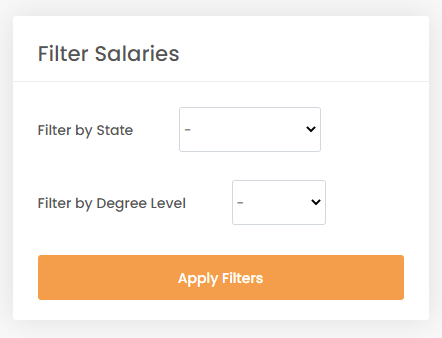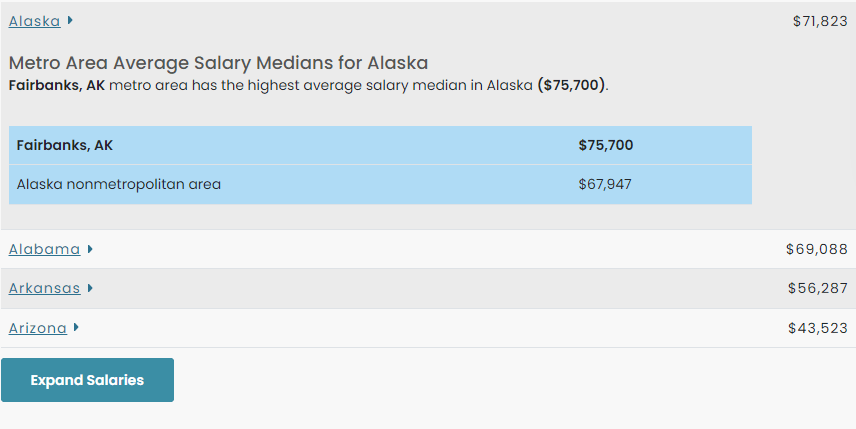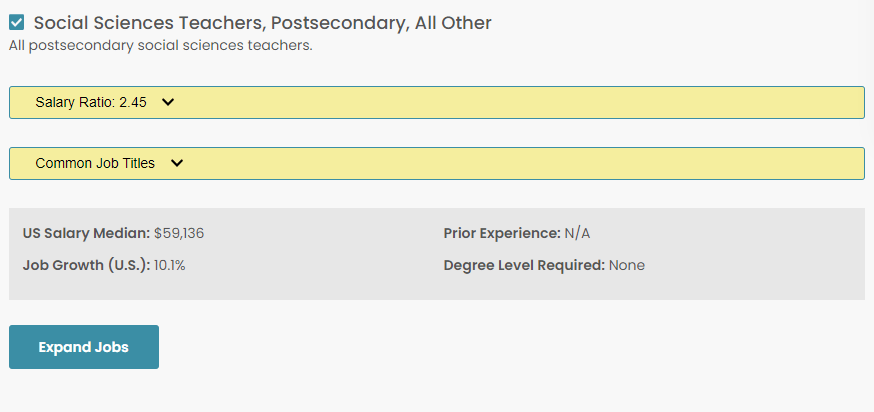Where Do I Start?
You have three options:
- Degree Page, which lists average job growth and salary outcomes
- Category Page, which lists all the degrees organized under a category
- Search Page, which lists all degrees matching a search term
Degrees are organized by categories. At the time of this writing, there are approximately 45 categories to explore. If you browse the categories and can’t find the degree you want to research, you can use the search form above.
Degree Page
A degree page provides salary, job, and education cost outcomes for a degree. Use the “Filter Salaries” widget to show the average salary outcomes by degree level and by state.

Description
Every degree page begins with a description that explains what students can expect to learn in a particular degree program. If there are job opportunities associated with a degree, the description will summarize typical job duties.
Summary Stats
After the description, you can view a summarized list of statistics about the average salary median, average job growth average, and average college costs. You can also see which state and the metro area have the highest average salary median.
If there’s no information to show, then it implies that the government has not collected enough data about this degree and/or job opportunities associated with it. The career field or the degree might be too new. Or, there’s no demand among employers for that particular degree.
- Average Salary Median: the average salary median outcome for the entire U.S. with this degree or for the state if you’re using a state filter.
- Average of Job Growth Average: an average of all the national job growth averages of each job attainable with this degree.
- Avg. Years of Work Experience Needed: the average years of work experience needed to attain jobs (and the average salary median) with this degree.
- State and Metro Area With Highest Average Salary Median: the state and metro area with the highest average salary median.
- Avg. Undergrad. and Graduate Cost: the average cost to obtain an undergraduate and a graduate degree, organized by in-state and out-of-state costs.
- Avg. Combined Cost: the in-state and out-of-state average cost to obtain an undergraduate or graduate degree.
Most Required Degree [Level]
The summary section also includes a chart visualizing the percentage of employers requiring a certain degree level.
If you’re unfamiliar with degree levels, this refers to Associate’s, Bachelor’s, Master’s, and Doctorate degrees. The website also includes Certificates and no degrees (“None”) in this degree level list.

Salary Medians
After the summary sections, the website shows the average salary median for each state and each state’s metro area. To see the metro area average salary medians for a state, you can click on the state which will expand the salary median table.
The salary table will show information about the first four states. If there’s more information to display, you can click on the EXPAND button to display more of the table.

Job Opportunities
This section shows the job outcomes with a particular degree. It shows the salary median (which can be filtered by state), the degree level required, and the prior years of experience needed to be hired and to reach the median salary level. The job list is based on government data that collects information about employment outcomes for degrees and can be filtered by degree level.
The first four job roles are displayed. To show more jobs, click on the EXPAND button.

Average Education Costs and Top 20 Most Affordable Schools
Read an explanation about the average education costs to obtain this degree. The provided costs are based on the average years of schooling to obtain particular degree levels. For example, a Bachelor’s degree usually requires four years of schooling; thus, the costs provided are based on that amount of time. Certificates, Bachelor’s, and Associate’s are calculated using the average undergraduate education costs, while Master’s and Doctorates are calculated using the average graduate education costs (see the Summary section). These figures don’t account for transfers from a less expensive community college or other means of lowering the cost of attending universities.
View the top affordable schools to obtain a degree. It’s segmented by a list of undergraduate and graduate degrees (20 schools each). As with the aforementioned sections, you can click the EXPAND button to view the list of the 20 most affordable colleges.
Cite A Page
If you’re interested in citing a degree page, you can use the information in this section to use the preferred ways of providing citation. Link text is provided, as well as the URL to use for the degree page. For those who work with HTML editors, HTML code is provided which allows for easy copy-and-paste.
Hopefully, this guide is useful for helping you navigate the website and degree information. You can start exploring now or continue learning more ways to use this site.
